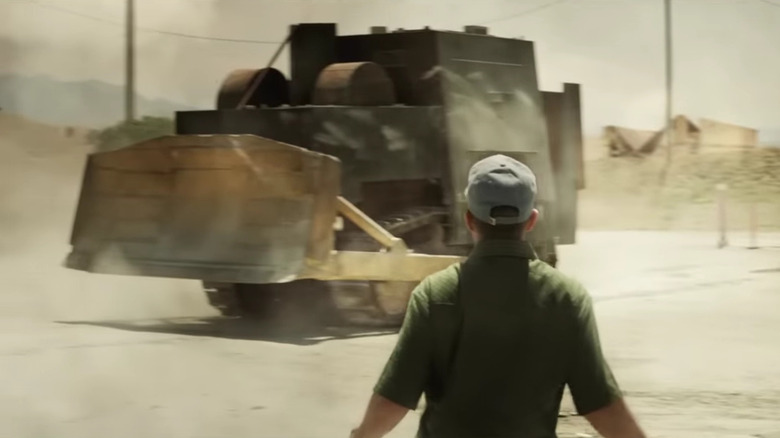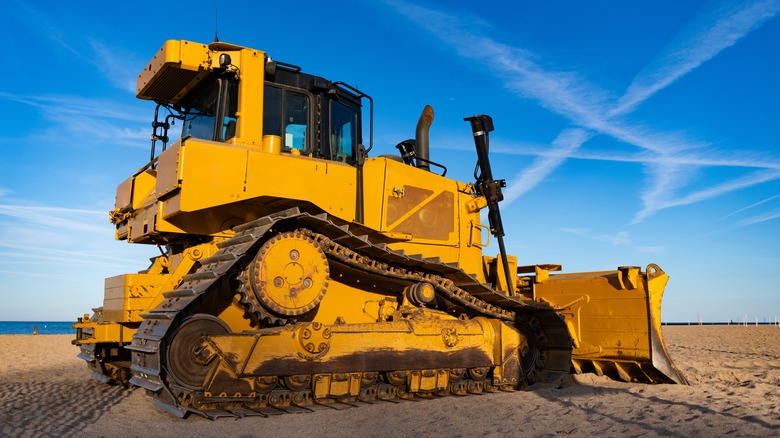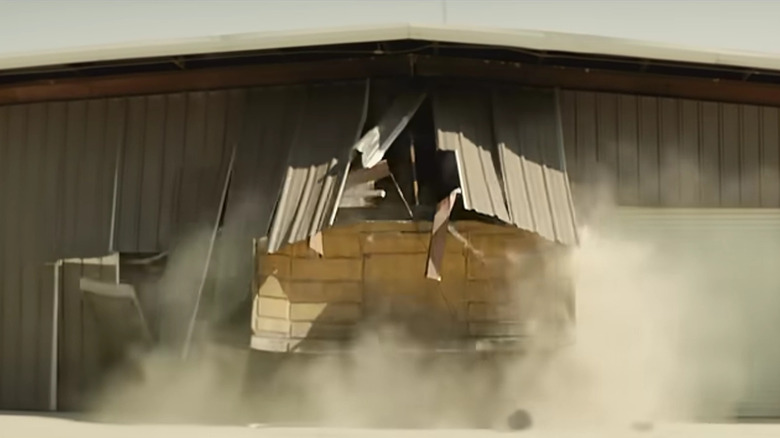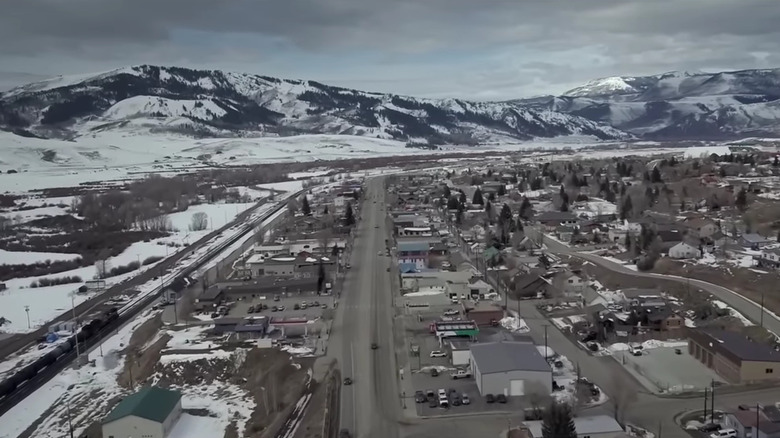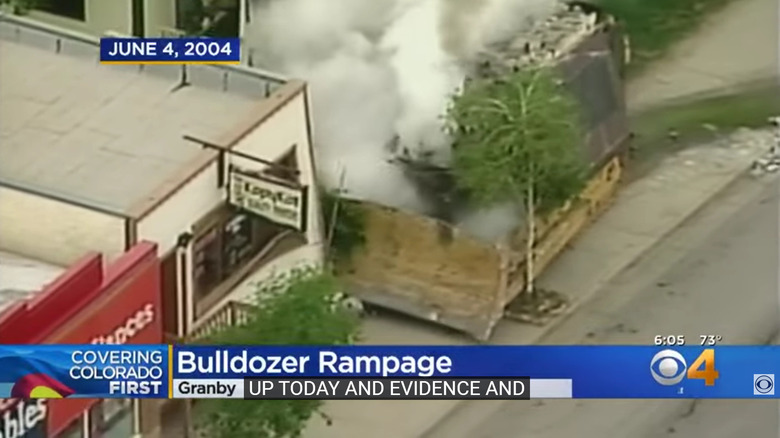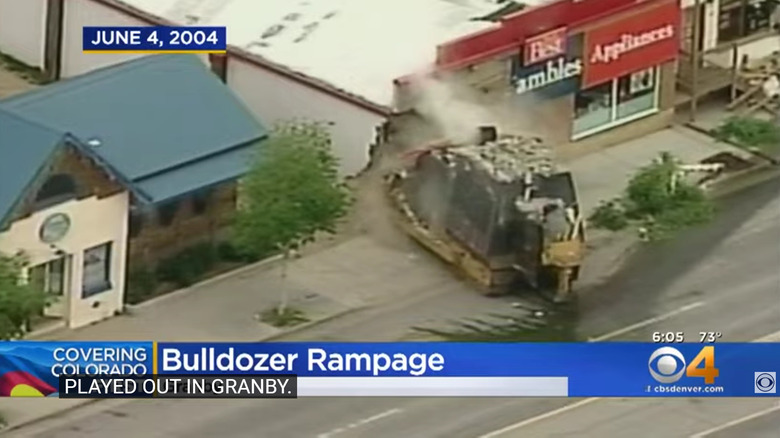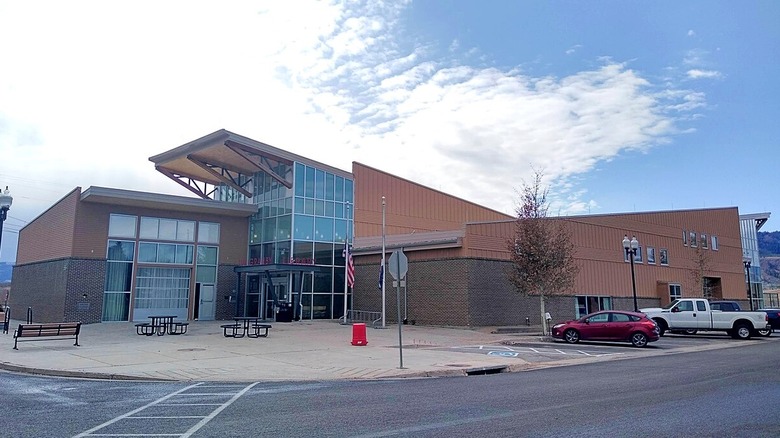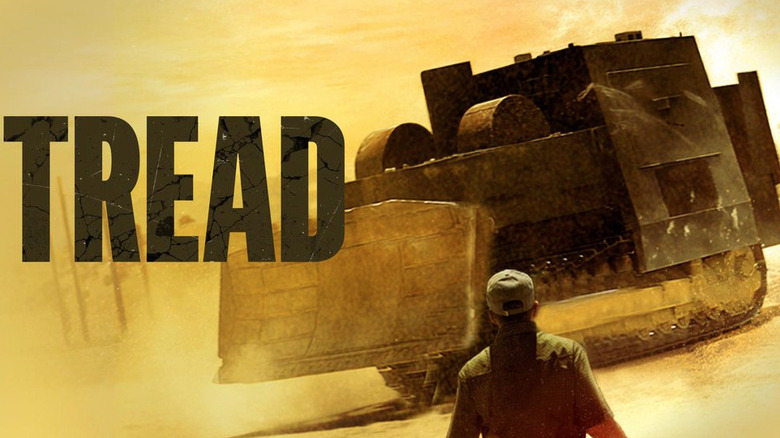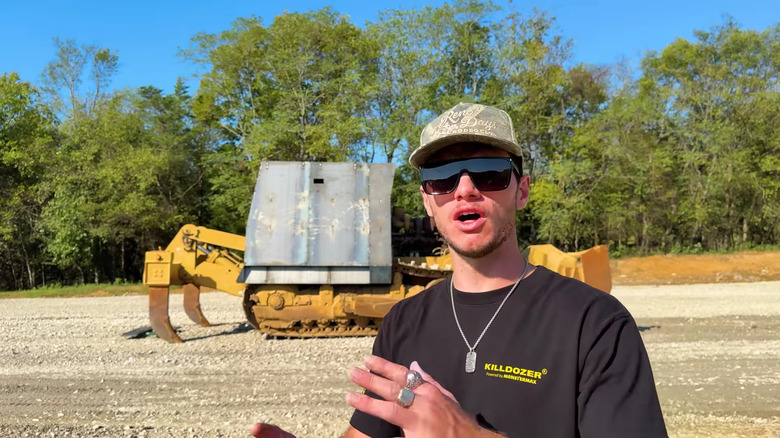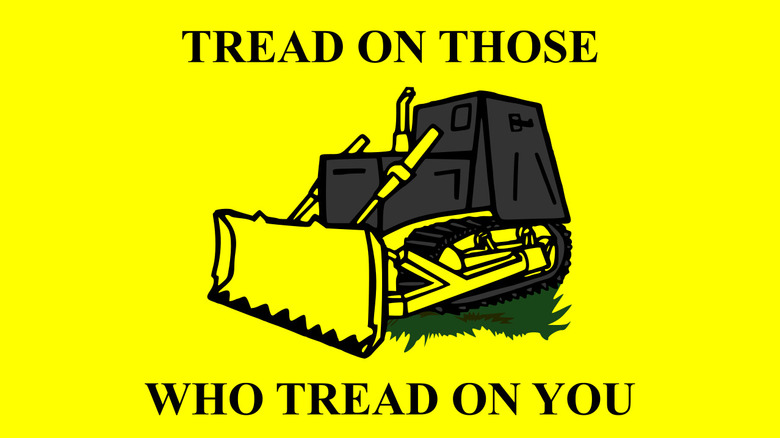The Bizarre Story Of The Killdozer Rampage
On June 4, 2004, a disgruntled middle-aged man named Marvin Heemeyer enacted his plan to take vengeance on the sleepy mountain town of Granby, Colorado. Angry at the town government and his neighbors, Heemeyer had armed and fortified a bulldozer, outfitting it with cameras and guns to build a homemade but formidable tank. This weapon on wheels, dubbed the "Killdozer" in subsequent media coverage, allowed Heemeyer to smash vehicles and buildings as he crunched his way through Granby.
Despite firing many shots at the first responders reacting to his rampage and leveling a number of buildings, Heemeyer's only human victim was himself. He died by suicide when the Killdozer became mired in the basement of a hardware store beyond hope of retrieval. The vehicle and its operator have since been feted by some anti-government extremists who apparently agree with Heemeyer that driving an armored bulldozer through a public library with children inside is an understandable response to being told to install a septic tank.
He was a quiet man
Before he built the Killdozer, Marvin Heemeyer was almost the definition of "some guy." He was born in 1951 in South Dakota and moved to Colorado in the 1970s after a stint in the U.S. Air Force. He apparently lived in Boulder for a while, but he also opened a few muffler shops around Denver and, later, in Granby. He never married but otherwise seemed to be almost the average American — a veteran small business owner you can imagine being interviewed as a swing-state voter in an election year under happier circumstances. Records are not always completely clear about Heemeyer's life, and why would they be? He didn't seem particularly important until he tried to flatten a mountain town like a soda can.
Those who knew Heemeyer were apparently as surprised as anyone by the Killdozer affair, and they only had pleasantly bland things to say about him in contemporary news reports. As reported by The Denver Post, they used terms like "down-to-earth," "regular," and "average," which are hardly ringing endorsements but also don't paint a picture of a high-strung personality ready to snap. Some fellow Granby residents were warier of Heemeyer, though, with some describing "Marv" as an irritable, even volatile man who could and did hold a grudge.
He was also a doomsday prepper
Marvin Heemeyer had another visible quirk beyond his occasional volatility: He was a doomsday prepper, a subculture/hobby/survival plan that entails prepping supplies for the end times. Some people are laying in enough supplies to comfortably weather relatively small-scale crises like a local natural disaster, while others outfit bunkers for the literal, actual end of the world by asteroid, nuclear war, or other wrath-of-God or folly-of-man catastrophes.
Preppers are not necessarily irrational — 2020 taught a lot of us to keep some water and granola bars on a high shelf, just in case. But when it comes to political ideology, adherents have traditionally overlapped with the American right wing. Recent political tension in the U.S. has heralded the rise of the lefty or centrist prepper, but in Heemeyer's day, the "prepper" archetype was associated with the gun-toting, government-skeptical far right. Though most of these people don't go on to outfit construction vehicles to serve as one-man armored divisions to pursue personal vendettas, Heemeyer both fit and contributed to a stereotype that conflates preparation with violence.
He became disgruntled at interference in his business
In the mid-90s, Marvin Heemeyer first started to seethe at the city government and media when he was on the losing side of a proposal to bring casino gambling to the area. Despite Heemeyer's establishment of a pro-gambling newspaper (with a two-issue run), the existing papers in the county opposed the proposition, and voters decisively shot down the proposal in a referendum. A land dispute at his business soured Heemeyer further.
In the early 2000s, a concrete factory owned by the Docheff family moved to a property adjacent to Heemeyer's business after some jockeying over zoning, a move Heemeyer had opposed. Per Heemeyer, the new property lines meant he had to drive through the concrete company's property to access his own. At some point during this dispute — accounts vary slightly, given that zoning regulations bore most people except those most angry about them — Heemeyer was fined for not having a proper septic tank or sewer connection. Some reports claimed the construction prevented him from hooking up to the town sewer. Regardless, Heemeyer paid the fine with a check, writing "COWARDS" on the memo line. Frustrated, in 2003, Heemeyer sold most of the land to a junk company and auctioned off the related assets. He leased back a shed in which he kept the only major piece of equipment he'd kept: a bulldozer.
To avenge himself on Granby, Heemeyer armed and fortified a bulldozer
The genius of the armored tank is its simplicity: Armor something, equip it with weapons, move it forward on treads, and you've got a tank. And if Eastern Bloc families could make homemade tanks to punch through the Iron Curtain with the limited resources available (one of the many unbelievable Cold War escapes), Marvin Heemeyer could certainly do it with a bulldozer and access to American resources. The Komatsu D355A bulldozer is a big boy, weighing just shy of 100,000 pounds, boasting 410 horsepower (that's a lotta horse!), and able to haul nearly 20 cubic yards of material with its blade. Its speed tops out at a tad less than 8 mph, but that's fast enough for all non-rampage purposes. (Note that these specs are without armor — Heemeyer's kitted-out version would have sacrificed some speed and power.)
To this base, Heemeyer added steel plates and impact-resistant Plexiglass, along with a ventilation system and cameras — themselves heavily protected with thick plastic — that fed to monitors inside the vehicle. (He also treated himself to air conditioning.) Rifles were mounted at the front, rear, and right of the Killdozer, and small firing ports allowed Heemeyer to use either of the two pistols he had in the cab with him. His last precaution was the most simple and the most nearly comical: He covered the exterior of the vehicle with grease to make it slippery enough to complicate any attempts to board it.
On June 4, 2004, Heemeyer set out in the Killdozer
On June 4, 2004, Marvin Heemeyer was ready to roll. He bolted himself into the Killdozer and made a dramatic entrance of sorts when he smashed through the side of the shed in which he had built the vehicle, avoiding the potentially awkward scene of people asking him why he was clambering into a greasy bulldozer with guns sticking out of it. The Killdozer, in fact, had no exit: The top was lowered on from outside from a crane Heemeyer had rigged, meaning he was in for the duration and effectively impossible to extract without his cooperation.
His first target was the Docheff concrete works next door. As Heemeyer was wrecking the operation, owner Cody Docheff tried to confront him in one of his own construction vehicles, but without armor, Docheff was no match for the Killdozer. Docheff quickly changed his tactic to escape, getting rear-ended by the Killdozer in the process and evading fire from Heemeyer's gun turrets. With Docheff in retreat and his business demolished, Heemeyer had exacted revenge on the first of his alleged persecutors. He then turned the Killdozer toward Granby.
Heemeyer smashed through Granby, demolishing buildings
It's hard to imagine the surprise Granby's residents would have felt on that previously unremarkable summer afternoon as an armored bulldozer arrived in the city center and began smashing up vehicles and buildings like a child with a sandbox full of Hot Wheels. Even at five miles an hour, the homemade tank's advance was frightening — just as Marvin Heemeyer intended. Some of his targets "made sense," at least by Heemeyer's standards: The offices of the newspaper that had opposed his gambling plans, the police station, the home of a former mayor (who, though dead, apparently remained on Heemeyer's nerves), and the town hall where the government of "hostile" Granby operated. The doomed town hall shared its premises with the library, in which several children were present, and they successfully fled only minutes ahead of the Killdozer's arrival. Cars were especially easy targets for Heemeyer, as the Killdozer could easily ravage on its way between Heemeyer's targets.
Many of these buildings, in fact, had people in them at the time of the Killdozer rampage: June 4, 2004, was a Friday, with most people still wrapping up the workweek. The newspaper editors, working on coverage of the rampage itself, had to flee as Heemeyer approached. They were safe, but the building was effectively obliterated. A small mercy came when Heemeyer was unable to cause an explosion at a propane company: He shot repeatedly at the storage tanks, trying to ignite them, but they held.
A policeman boarded the vehicle but couldn't break in to stop Heemeyer
As the rampage continued, and Marvin Heemeyer showed no sign of stopping, every jurisdiction and agency available began trying to take out the killdozer. The Grand County sheriff's office, the Colorado State Patrol, the U.S. Forest Service, and a SWAT team all sent men and materiel to hamstring the Killdozer, but Heemeyer's vengeance-mobile had been built well. Gunfire failed to take out the machine or its driver, as did plastic explosives and a flash-bang delivered to the vehicle's tailpipe. Allegedly, anti-tank guns and helicopter-fired Apache missiles were both considered, but their use on the streets of an American town would have caused both collateral damage and probable political complications.
A brave Granby undersheriff, Glen Trainor, managed to scramble up the oily exterior of the Killdozer and evade the guns, but once atop the vehicle, he had no more success than his fellows. The armor was strong and tightly sealed, and it held up to Trainor's firing 37 rounds at it from close range. This fusillade no doubt left Heemeyer's and Trainor's ears ringing, but a service pistol was no match for the reinforcements Heemeyer had installed.
Heemeyer died by suicide after the Killdozer's radiator blew out
Marvin Heemeyer and his Killdozer were finally thwarted by a combination of other people's bravery, bad luck, and bad strategy. A heavy industrial loader, one of the few machines available in the Killdozer's weight class, managed to corner the Killdozer, meaning that its only escape lay through a block of buildings. This hadn't slowed Heemeyer down yet, but even a Killdozer can't crunch through walls forever. The exact sequence of events isn't totally clear, but either before or during this cornering by the loader, the Killdozer's radiator blew out, limiting the lifespan of the straining motor.
Heemeyer tried to escape through a hardware store, but he didn't realize that it had a basement — and a floor that hadn't been designed to support the full weight of a bulldozer. The heavy, ailing Killdozer fell into the basement and had no way out. Policemen heard a single shot from inside the Killdozer, but it took them several hours of work with oxyacetylene torches and cranes to open the vehicle and confirm Heemeyer's death by suicide. In about two hours, Heemeyer had destroyed 13 buildings and dozens of vehicles, causing some 7 million dollars' worth of damage. Despite repeatedly firing at first responders, Heemeyer had only taken one life: his own.
Granby rebuilt
Granby rebuilt itself after the rampage, with the community banding together and working to come back stronger. Today, the savaged downtown area is prettier and more modern after a years-long restoration that included a bit of a facelift. Local people worked to raise funds through a variety of projects, ranging from bake sales and grant applications to a "Ladies of Granby" cheesecake calendar. The saucy project brought in $40,000.
Even without the high death toll Heemeyer apparently envisioned, the town still has to manage the trauma of his attack. Strangers know one thing about Granby, and it's not that the new library and community center won an architectural award. The town still gets a trickle of disaster tourists who want to see where it all went down. On the 20th anniversary of the attack in 2024, several downtown businesses and buildings closed, and local police increased their presence, hoping to foil or limit the damage from a copycat attack. And even in Granby, Marvin Heemeyer has postmortem supporters who condone his extremist response to disappointment.
The incident inspired documentaries and memoirs
Unsurprisingly, the Killdozer incident has inspired a fair amount of media, both from outsiders and from survivors. Because titles can't be copyrighted, there are a handful of books titled "Killdozer," though, admittedly, this includes a science fiction work that predated Marvin Heemeyer's fatal tantrum. These range from the book by Patrick Brower, the editor of the Sky-Hi News outlet that was a target of Heemeyer's, to a thinly veiled sympathetic novelization in which the Heemeyer character "beds beautiful women," to a choose-your-own-adventure role-playing product that advises readers to have a ten-sided die ready.
The 2019 documentary "Tread," freely available online, was based on Brower's book. Brower himself has given a number of interviews and speaking engagements, some connected with screenings of the documentary and at least one in Granby itself, pushing back against the anti-hero narrative that has sprung up around Heemeyer's actions and contextualizing him not as an anti-government rebel but as simply a spree killer who didn't kill the innocents he hoped to.
In 2024, a YouTuber attempted to improve on the design of the Killdozer
Recently, the Killdozer has been reconstructed in a series of experiments carried out by YouTuber WhistlinDiesel, government name Cody Detwiler. Detwiler's content is all about gimmicky and extreme experiments with vehicles, performing stunts like destroying a 1916 Ford Model T in a durability test and putting 17 turbochargers on a 2006 Dodge Ram, which caused it to catch fire.
In 2024, Detwiler uploaded a series of videos in which he largely reconstructed the Killdozer (down to the gun turrets, natch), adding a few upgrades and improvements to Marvin Heemeyer's original design. The fatal cooling-system flaw was addressed, and the armor was created within a millimeter of tolerance. Detwiler smashed cars and even an RV with his new toy, also camping out in it one night and filming the latest installment in a running bit in which he pretends to accidentally run over his own grandmother. Detwiler did pass through Granby during the project, interviewing some townspeople and witnesses and providing what might generously be called an oral history of the incident. Less charitable observers may point to his statement that most of what you read online is "biased against" Heemeyer.
Heemeyer is a folk hero in some circles, but may be inspiring copycats and other violence
Marvin Heemeyer has become a folk hero in some corners, with people admiring his can-do attitude and take-no-prisoners approach to zoning disputes. He's been featured as one of the titular heroes on the long-running website Badass of the Week, garnering a write-up as fawning as it is gleefully, unquotably profane, and denizens of some corners of the internet celebrate June 4 as "Killdozer Day."
So far, so playful, but some commentators, including author and survivor Patrick Brower, argue that the Killdozer incident was an act of domestic terrorism — complete with the potential to inspire similar attacks. In 2008, a bulldozer was used in a ramming attack in Jerusalem, killing three. More broadly, vehicle-ramming attacks in general have become more common in recent decades, including the 2017 London Bridge and 2025 New Orleans attacks. The FBI notes that this style of attack is particularly favored by far-right actors, though ISIS has also provided tips for a successful such operation in their materials.
If you or someone you know is struggling or in crisis, help is available. Call or text 988 or chat 988lifeline.org.
